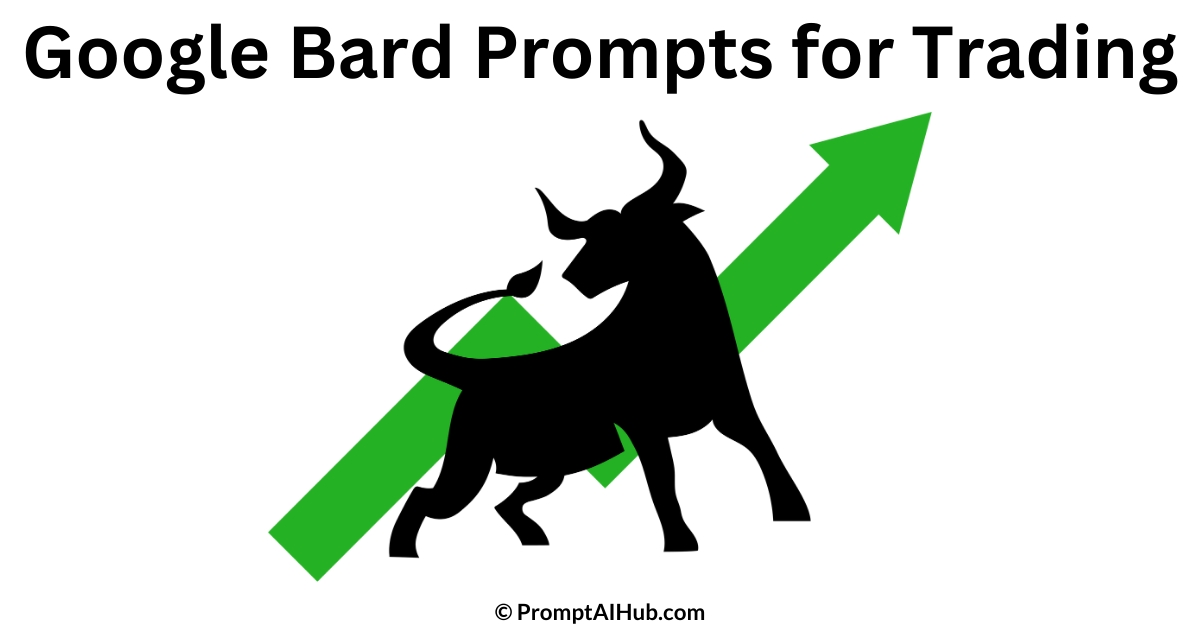“Google Bard Prompts for Trading” is your gateway to enhancing your trading expertise. You don’t need to be a corporate expert; our article simplifies the process. After reading this, you’ll trade with newfound confidence, mastering effective strategies that set you apart in the market.
Visit Here: 141 Tested Google Bard Prompts For Marketing – Boost Productivity
Business Prompts
All Google Bard Prompts for Trading
1. Technical Analysis: Discuss the importance of technical analysis in trading. Explain key technical indicators, chart patterns, and how traders use them to make informed decisions.
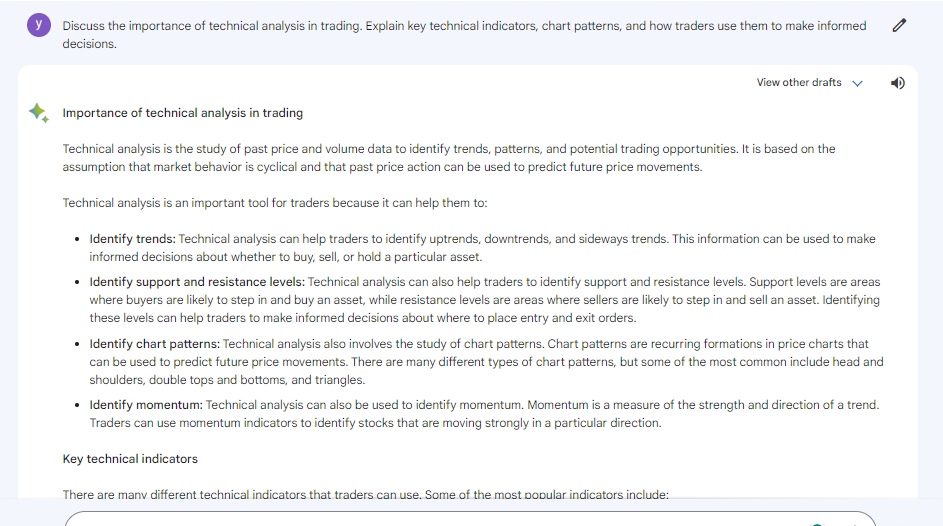
2. Risk Management Strategies: Describe various risk management techniques that traders employ to protect their capital. Discuss the concept of stop-loss orders, position sizing, and risk-reward ratios.
3. Market Psychology: Explore the role of psychology in trading. Explain common psychological biases that affect traders and provide strategies for maintaining emotional discipline.
4. Trading Strategies: Compare and contrast different trading strategies, such as day trading, swing trading, and long-term investing. Discuss the advantages and disadvantages of each approach.
5. Fundamental Analysis: Explain how fundamental analysis is used in trading, focusing on factors like earnings reports, economic indicators, and industry trends. Provide examples of how fundamental analysis can impact trading decisions.
6. Trading Platforms and Tools: Provide an overview of popular trading platforms and tools available to traders. Discuss their features, fees, and the types of assets they support.
7. Trading in Cryptocurrencies: Dive into the unique challenges and opportunities of trading cryptocurrencies. Explain how blockchain technology and market sentiment play a role in crypto trading.
8. Day Trading Strategies: Discuss various day trading strategies, including scalping and momentum trading. Explain the importance of timing, entry and exit points, and managing risk in intraday trading.
9. Options Trading: Introduce options trading and explore different strategies, such as covered calls, protective puts, and straddles. Discuss how options can be used for hedging or generating income.
10. Global Market Dynamics: Analyze the interconnectedness of global markets and how geopolitical events, economic news, and central bank policies can impact trading decisions. Provide insights into how traders can stay informed and adapt to changing market conditions.
11. Risk Management Strategies: Discuss various risk management techniques and their importance in trading. Explain how traders can use stop-loss orders, position sizing, and risk-reward ratios to protect their capital.
12. Technical Analysis Tools: Provide an in-depth guide on essential technical analysis tools such as moving averages, Bollinger Bands, and Relative Strength Index (RSI). Explain how traders can use these tools to make informed decisions.
13. Fundamental Analysis for Forex: Explain the fundamentals of forex trading, including how to analyze economic indicators, central bank policies, and geopolitical events to make currency trading decisions.
14. Options Trading Strategies: Describe popular options trading strategies such as covered calls, iron condors, and straddle/strangle. Explain when and how to use these strategies effectively.
15. Cryptocurrency Trading: Discuss the unique challenges and opportunities in cryptocurrency trading, including how to analyze blockchain projects, navigate market volatility, and choose secure exchanges.
16. Day Trading vs. Swing Trading: Compare and contrast day trading and swing trading, highlighting the pros and cons of each approach. Provide guidance on selecting the best style based on individual goals and risk tolerance.
17. Algorithmic Trading: Explain the basics of algorithmic trading, including how to develop, backtest, and implement trading algorithms. Discuss the advantages and risks associated with algorithmic trading.
18. Market Psychology: Explore the psychological aspects of trading, focusing on common behavioral biases that affect traders. Discuss techniques to overcome fear, greed, and emotional decision-making in the markets.
19. Commodity Trading Strategies: Provide an overview of commodity trading, including strategies for trading commodities like gold, oil, and agricultural products. Explain how factors like supply and demand, weather, and geopolitical events impact commodity prices.
20. Risk-on and Risk-off Markets: Explain the concept of risk-on and risk-off sentiment in financial markets. Describe how different assets, such as stocks, bonds, and currencies, react to changes in risk appetite and how traders can adapt their strategies accordingly.
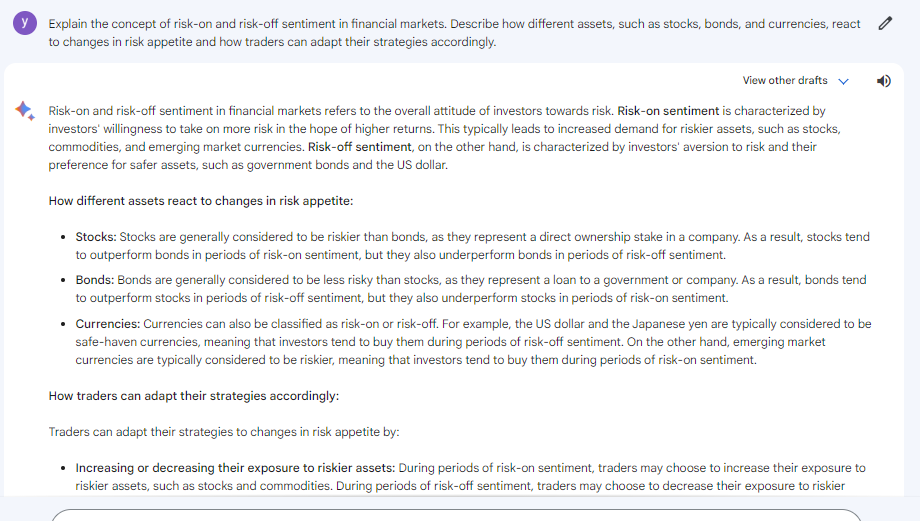
21. Diversification Strategies: Discuss the importance of diversification in a trading portfolio. Explain how to spread risk across different asset classes, industries, and geographic regions.
22. Swing Trading with Candlestick Patterns: Explore how traders can use candlestick patterns to identify potential trend reversals and entry/exit points in swing trading. Provide examples and best practices.
23. Risk-on and Risk-off Indicators: Identify key indicators that signal shifts in risk sentiment, such as the VIX (Volatility Index) and government bond yields. Explain how traders can use these indicators to gauge market sentiment.
24. Trading Psychology and Mindset: Dive deep into the psychological aspects of trading, including topics like discipline, patience, and the importance of maintaining a trading journal.
25. Options Greeks and Volatility: Explain the various options Greeks (Delta, Gamma, Theta, Vega) and how they relate to options pricing and managing risk in different market conditions.
26. Trading Forex Pairs: Provide an overview of how to trade currency pairs, including the major, minor, and exotic pairs. Discuss factors that influence exchange rates and how to analyze them.
27. Pairs Trading Strategy: Describe the concept of pairs trading and how it can be used to profit from relative price movements between two correlated assets. Provide practical examples.
28. Cryptocurrency Technical Analysis: Explore advanced technical analysis techniques specific to cryptocurrency markets, including chart patterns and indicators relevant to digital assets.
29. Alternative Investments: Discuss trading opportunities in alternative assets such as real estate investment trusts (REITs), collectibles, and peer-to-peer lending platforms.
30. Market Order Types: Explain the different types of market orders, including market, limit, stop-loss, and trailing stop orders. Clarify when and how to use each order type effectively.
31. Options Spreads: Delve into advanced options spread strategies like iron butterflies, ratio spreads, and calendar spreads. Explain their risk-reward profiles and ideal market conditions.
32. Hedging Strategies: Discuss various hedging techniques that traders can use to protect their positions from adverse market movements. Examples include using options, futures, and inverse ETFs.
33. Global Economic Events and Trading: Analyze the impact of major economic events, such as non-farm payrolls, GDP releases, and central bank decisions, on trading strategies and market behavior.
34. Market Sentiment Analysis: Explain how traders can gauge market sentiment through sources like social media, news sentiment analysis, and options market data.
35. Trading in Volatile Markets: Offer strategies for trading in highly volatile markets, including risk mitigation, setting wider stop-loss levels, and taking advantage of increased price swings.
36. Position Sizing Models: Provide detailed information on various position sizing models, such as the Kelly Criterion and fixed fractional position sizing. Discuss their application in risk management.
37. Options Implied Volatility: Explore the concept of implied volatility and its role in options pricing. Explain how traders can use implied volatility to make informed options trading decisions.
38. Trading During Earnings Season: Discuss strategies for trading stocks and options during earnings season, including the use of straddles and strangles.
39. Cryptocurrency Security: Educate traders on the importance of securing their cryptocurrency holdings through hardware wallets, multi-signature setups, and safe practices.
40. Behavioral Finance in Trading: Dive into behavioral finance concepts like anchoring, confirmation bias, and overconfidence and how they impact trading decisions.
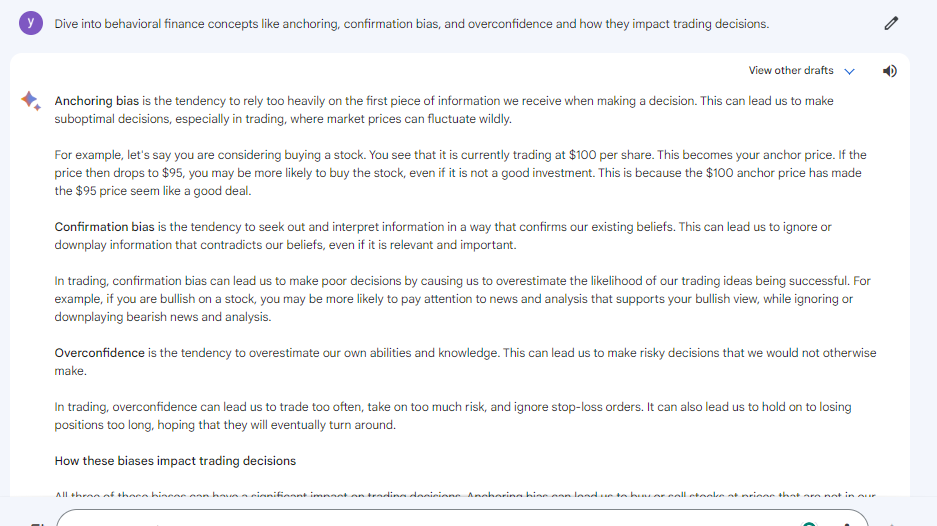
41. High-Frequency Trading (HFT): Explore the world of high-frequency trading, discussing the technology, strategies, and risks associated with HFT in equities, futures, and forex markets.
42. Algorithmic Trading Strategies: Provide an overview of popular algorithmic trading strategies, including mean-reversion, momentum, and statistical arbitrage. Explain how to implement these strategies and their advantages.
43. Market Structure and Liquidity: Explain the structure of financial markets, discussing order books, market makers, and liquidity providers. Explore how market structure affects trading strategies.
44. Risk Parity Strategies: Describe the concept of risk parity and how it can be applied to create diversified portfolios that balance risk across different asset classes.
45. Options Volatility Skew: Dive into options volatility skew and how it impacts option pricing and strategy selection. Discuss the implications of skew for traders.
46. Pairs Trading with Cointegration: Explore pairs trading with a focus on cointegration, a statistical technique used to identify long-term relationships between two assets. Provide examples and insights.
47. Quantitative Trading Models: Discuss quantitative trading models, including statistical arbitrage, machine learning-based models, and their applications in various asset classes.
48. Advanced Chart Patterns: Provide an in-depth analysis of advanced chart patterns such as head and shoulders, double tops/bottoms, and cup and handle formations. Explain their significance and how to trade them.
49. Cryptocurrency Trading Strategies for Altcoins: Share trading strategies specifically tailored for trading altcoins within the cryptocurrency market, addressing factors like liquidity, market capitalization, and technology.
50. Trading the Economic Calendar: Explain how traders can use economic calendars to plan their trading around important economic events, including data releases, speeches, and elections.
51. Quantitative Risk Management: Discuss quantitative approaches to risk management, such as Value at Risk (VaR) and Conditional Value at Risk (CVaR). Explain their calculations and applications.
52. Market Orders vs. Limit Orders: Clarify the differences between market orders and limit orders and when to use each type for entering and exiting positions.
53. Options Trading for Income: Explore income-generating options strategies like covered calls, cash-secured puts, and iron condors. Discuss the potential risks and rewards.
54. Trading Psychology in Stressful Situations: Address how traders can manage stress and anxiety during highly volatile and stressful market conditions. Share coping strategies and techniques.
55. Risk Factors in Commodities: Discuss the unique risk factors associated with trading commodities, including weather-related risks, geopolitical events, and the impact of global supply chains.
56. Machine Learning for Trading: Provide an introduction to using machine learning algorithms for trading, including data preparation, model selection, and backtesting.
57. Trading on Margin: Explain the concept of margin trading and how to effectively use leverage while managing risk in various asset classes.
58. Sentiment Analysis Tools: Review sentiment analysis tools and techniques used by traders, including social media sentiment analysis, news sentiment data, and sentiment indicators.
59. Short Selling Strategies: Discuss strategies for profiting from falling markets through short selling, including short squeezes, risk management, and regulatory considerations.
60. Trading Ethics and Compliance: Explore the ethical and compliance considerations that traders and investors should be aware of, including insider trading, market manipulation, and regulatory compliance.
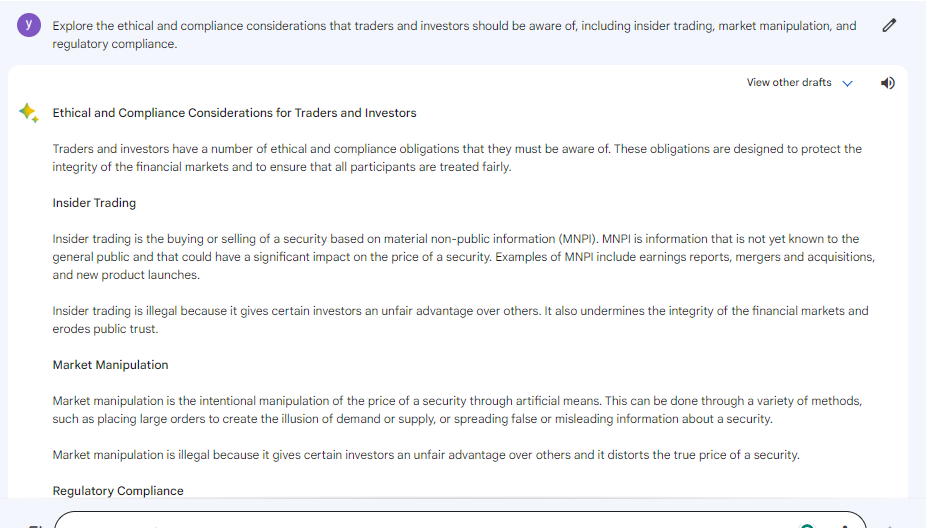
61. Options Risk Management: Delve into advanced options risk management techniques, including delta hedging, gamma scalping, and volatility adjustments to protect and optimize option positions.
62. Market Correlations and Trading: Explain the concept of market correlations and how traders can use them to diversify portfolios and identify potential trading opportunities.
63. Global Macro Trading: Explore the strategies employed by global macro traders who make trading decisions based on global economic and geopolitical factors. Discuss the importance of macroeconomic indicators and events.
64. Trading Cryptocurrency Derivatives: Discuss the world of cryptocurrency derivatives, including futures and options, and how traders can use these instruments to speculate and hedge positions.
65. Order Flow Analysis: Explain how traders can analyze order flow data, such as order book depth, to gain insights into market sentiment and potential price movements.
66. Commodity Futures Trading: Provide an in-depth overview of trading commodity futures contracts, discussing contract specifications, margin requirements, and the role of futures in hedging.
67. Risk-Adjusted Returns: Explore methods for measuring and optimizing risk-adjusted returns, including the Sharpe ratio, Sortino ratio, and the use of portfolio optimization techniques.
68. Volatility Trading Strategies: Discuss strategies for trading volatility, such as the use of VIX derivatives, options straddles, and volatility risk premium strategies.
69. Machine Learning for Trading Execution: Explain how machine learning can be applied to optimize trading execution, including order routing, slippage analysis, and market impact modeling.
70. Alternative Data Sources for Trading: Explore the world of alternative data, discussing how traders can use non-traditional data sources like satellite imagery, social media sentiment, and web scraping for trading insights.
Visit Our Free AI tools
Prompts AI Hub Team Has Tailored Their AI Knowledge and Created Tools for You Free of Cost, Enjoy
Final Thoughts:
In conclusion, “Google Bard Prompts for Trading” empowers traders to excel. Discover actionable insights, refine your trading skills, and stay ahead in the market. Elevate your trading game with this essential resource.
Download All Google Bard Prompts Here
Click the Button Below to Download Google Bard Prompts.
What are the key advantages of using Google Bard prompts for trading?
Google Bard prompts for trading offer valuable insights, strategies, and guidance to traders, helping them make informed decisions and enhance their trading skills.
How can traders optimize their risk management using these prompts?
Traders can use Google Bard prompts to explore advanced risk management strategies, including position sizing, stop-loss orders, and options risk management techniques.
Can these prompts help traders navigate volatile markets effectively?
Yes, traders can use these prompts to learn strategies for trading in volatile conditions, such as using options, managing market orders, and leveraging sentiment analysis.
Do the prompts cover cryptocurrency trading and alternative assets?
Absolutely, these prompts delve into cryptocurrency trading strategies and explore opportunities in alternative assets, ensuring a comprehensive trading knowledge base.
Do I need to be a trading expert to make use of these prompts?
No, the prompts are designed to simplify complex trading concepts, making them accessible even to those without extensive trading experience.
For More Information, About Author Visit Our Team

